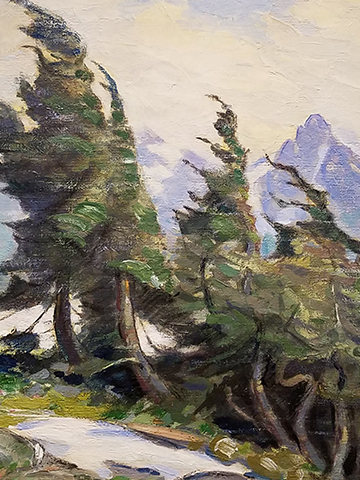Gale Fiege of the Everett Herald, Fri Jul 14th, 2017 9:08am
EDMONDS — Cascadia Art Museum curator David Martin knows his stuff.
If you appreciate Northwest regional art from the first half of the 20th century and you ever have a chance to tour the museum with Martin, don’t hesitate.
I had the opportunity to tag along on the docent tour he led this past week just before the opening reception for the newest exhibit, “Northwest Impressions: The Paintings & Etchings of Paul Morgan Gustin.”
Martin is scholarly, funny, engaging and he likes to dish about the artists.
The curator knows much because over the years he has made it a point to get to know the families and friends of many of the people whose works are featured at the museum.
Gustin is a good example of Martin’s scholarship.
The artist died in 1974. Later, Martin formed a friendship with Gustin’s widow (who had been the artist’s housekeeper) and at one point helped her uncover a stash of Gustin’s etchings.
The Frye Art Museum in Seattle accepted the donation of these works. The museum asked Martin to write the catalog for the 2004 Frye exhibit, “From Lake Union to the Louvre: The Etchings of Paul Morgan Gustin.”
Many of the etchings displayed at Cascadia were framed and loaned by the Frye.
Born at Fort Vancouver, Washington, in 1886, Gustin was reared in Denver, Colorado, where he studied art with Jean Manheim. The painter returned to the Northwest in 1906, moving to Seattle where he was inspired by the majestic beauty of the landscape and its ever-changing atmospheric weather conditions. He became nationally known for his depictions of Mount Rainier and mountains in the Olympics and Cascade ranges, Martin said.
Gustin first exhibited nationally at the Pennsylvania Academy of Fine Art in 1910 and later with the Corcoran Gallery, Washington, D.C., and the Art Institute of Chicago, among others.
“I grew up in New York where there is no Mount Rainier, and I can imagine being wowed by his mountain paintings,” Martin said. “At the time, people just had not seen anything like Mount Rainier. Gustin was an ambassador for the Northwest.”
Gustin also had six paintings in the 1915 Panama-Pacific International exhibition in San Francisco, where he was honored by serving on the exhibition jury.
He had many successful regional shows with the Seattle Fine Arts Society, predecessor to the Seattle Art Museum, and later was included in solo and group exhibitions at SAM.
From 1923-1926, Gustin traveled throughout Europe where he studied at the Academie Colarossi, Academie Ranson and Academie de la Grande Chaumiere. In 1925, he exhibited in the Paris Spring Salon.
One can see his commissioned murals, including at Roosevelt High School in Seattle, Washington State University and in the University of Washington’s Suzzallo Library. His work is in the permanent collections of the Seattle Art Museum and the Henry Art Gallery.
“He really was one of the region’s finest painters,” Martin said.
His friend and rival Roi Partridge, an etcher married to famed Seattle photographer Imogen Cunningham, good-naturedly tried to discourage the painter from trying etching. It’s a story Martin likes to tell.
“Don’t ever try etching, Gustin,” Partridge wrote to his friend. “Why? Well firstly, you would cause me to fade into insignificance; secondly, because you would at once buy a ($150) press, and if you are a true artist, I know you cannot afford it; thirdly because you would stop painting and that would be quite damnable.”
One of the rooms in the exhibit is dedicated to Gustin’s etchings and it includes an example of Partridge’s work as well. The cityscapes are dark, and especially appealing are the depictions of Pioneer Square and the Seattle waterfront.
“Gustin was a guarded and serious fellow,” Martin said. “In all the photos I could find, he is never smiling.”
The first room of the exhibit features work that Gustin did for millionaire attorney Frank Pratt Jr., who owned property on what is now Nature Conservancy land in the Ebey’s Landing National Historical Reserve near Coupeville on Whidbey Island.
“This is the first time these paintings will be seen by the public,” Martin said. “And the landscapes are still recognizable.”
Included in a display case of letters from Gustin to Pratt is a sketch of Pratt’s young son Robert, who later became a close friend to Gustin. Robert Pratt eventually married his housekeeper, too, and their son, Ron Hanson of Whidbey Island, now owns the Pratt collection of Gustin’s paintings.
Though many of his paintings were made in Washington state, Gustin also liked to travel.
Noteworthy in the exhibit is a painting of the Golden Gate at the mouth of San Francisco Bay before the bridge was built, an etching of a cathedral in France and paintings of First Nations people pulling their dugout canoes through the waters off western Vancouver Island.
To take your own tour with David Martin, sign up at www.cascadiaartmuseum.org/public-programs. The next Coffee with the Curator lectures are at 10 a.m. on Aug. 5 and Sept. 10. Cost is $15 for non-members.
Northwest Impressions: The Paintings & Etchings of Paul Morgan Gustin
Cascadia Art Museum is open 11 a.m. to 6 p.m. Wednesday through Sunday at 190 Sunset Ave., Edmonds, and is free from 5 to 8 p.m. during the Art Walk Edmonds’ Third Thursday events. Adult admission is $10. Students, active military and seniors are charged $7, a family admission is $25, and children age 5 and younger and members of the museum get in free. Call 425-336-4809 or go to www.cascadiaartmuseum.org.


